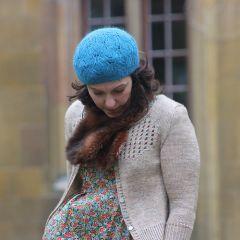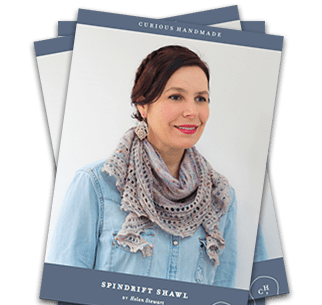Another lovely guest post as we ramp up in the early days of the Curious Handmade Wardrobe Challenge! Today I’m really lucky to introduce you to the wonderful Libby from Truly Myrtle. Libby is a designer, podcaster and blogger who is already living the handmade wardrobe dream, and she’s graciously agreed to join us here on the Curious Handmade blog to share her expertise. There’s so much gold in this post, and I think it will really inspire anyone taking their first steps into the world of the handmade wardrobe. Libby talks about how to find great patterns and offers her best tips for a successful project. She designs knitwear but is an avid and acocmplished sewist as well, and this post focuses mostly on sewing, which is a growth area for a lot of us knitters who would like to branch out and make garments to wear with our beloved knits.
* * * * *
 Hi everyone! I’m Libby from Truly Myrtle and I’m really excited to be posting on the Curious Handmade blog today! Thank you for inviting me Helen! I am an enthusiastic champion of handmade wardrobes and I knit and sew many of
Hi everyone! I’m Libby from Truly Myrtle and I’m really excited to be posting on the Curious Handmade blog today! Thank you for inviting me Helen! I am an enthusiastic champion of handmade wardrobes and I knit and sew many of
my own clothes. Much of what I know has been learnt through trial and error and I’m still learning every time I make something. These days I’m particularly keen to master the art of getting a perfect fit and a great finish as well as gaining skills in drafting my own knitting and sewing patterns. It’s proving to be another adventure!
As knitters, we are incredibly lucky to have Ravelry. It’s such a great resource for finding patterns, hearing what other have to say about them and seeing how they look on a variety of body shapes. But what about sewing? As yet there isn’t a similar resource and it’s daunting trying to figure out which sewing patterns to start with, how to find a pattern that you can master and what will suit you. I thought I’d share a few ideas about finding great sewing patterns and my favourite wardrobe staples.
GREAT PLACES TO FIND SEWING PATTERNS
– your local fabric store is probably a good place to start. They’re likely to stock fat catalogues of sewing patterns from all the major brands and the salespeople should be able to provide some good advice about what patterns will suit your level of experience. They might even offer classes!
– I’m always keen to support small creative businesses and there are many independent sewing designers online these days. Indiesew stocks a number of patterns from indie designers and their blog is full of tips and tricks to support you.
– google it! Searching “independent sewing patterns” will bring up a heap of designer pages.
Some of my favourites are:
I particularly like these ones because they all have great blogs full of helpful information. Some even do sew alongs and walk you through their patterns step by step. You’ll find there are many many more independent designers and it can be a bit of a rabbit hole once you get started! I like to click on “images” when I search to view pictures of sewing patterns to get a feel of what might be available.
– look in your local library. There are lots of fabulous learn to sew or beginner sewing books around and many include patterns. Maybe your library stocks some?
– are you on Instagram? Me Made May is a huge event each May and this year thousands of knitters and (especially) sewers posted pictures of their handmade clothes including names of the patterns they’d used, under the tags #mmmay15 and #memademay. I found it so helpful to see pictures of sewing patterns on real people. It’s also a great place to find my next idea …
– sewing bloggers. There are hundreds and hundreds of sewing bloggers online sewing and reviewing sewing patterns. Search “sewing bloggers” and prepare to be wowed.
SOME OF MY FAVOURITE BEGINNER PATTERNS
Beginner sewing patterns are great for new sewers, experienced sewers and sewers coming back to their machines after a break. Many beginner patterns are great wardrobe staples and can be adapted and adjusted as your skills and confidence increase. Here are some of my favourites:
– Tiny pocket tank from Grainline Studios. I’ve made several of these tops and they’re simple, require only a small amount of fabric and are a great summer wardrobe basic.
– Washi Dress from Made By Rae. I love this pattern and I live in my Liberty print cotton Washi dress through the summer. The instructions are easy to understand and the pattern is endlessly adaptable. I’ve made a Washi tank top from the basic pattern too.
– Clover Trouser Pattern. from Colette Patterns. Trousers can be scary to sew but this pattern is fairly simple and well supported on the Colette Patterns blog. You’ll learn how to put in a zip and how to get a good fit.
– Sewing with Knits Class by Meg McElwee. This a series of classes showing you how to make five sewing patterns (also included) rather than a sewing pattern per se but I thoroughly recommend it if you’d like to try sewing knits on your regular sewing machine. The patterns are great (the t-shirt pattern is my staple t-shirt) and you’ll have lifetime access to the classes showing you how to make each of the patterns.
– Alabama Studio Sewing & Design. This is a book rather than individual pattern but it is absolutely fabulous. The patterns in the book are very stylish basic shapes and are intended to be sewn by hand (the book is stuffed with wonderful information showing you how) but could also be sewn by machine. Personally, I love the hand-sewn look and I really encourage you to have a go with patterns like these if you’d like to try sewing but don’t have access to a sewing machine or want to sew out and about.
TIPS AND TRICKS
– Like it has for knitting, the internet has revolutionised sewing. Many of the sewing patterns from independent sewing designers are only available in pdf form so you’ll need to download them, print them out and then assemble them before you can use them. I’ve written a guide to help you work out how to quickly and easily get a pdf pattern ready for sewing.
– It’s a good idea to make a muslin. It’s a bit like a swatch; a test run of your pattern to make sure it fits you properly. I often make a “wearable muslin” from a fabric that’s a bit cheaper than my real fabric. Just make sure the two fabrics are similar in weight and feel.
– Ask for help. Don’t get discouraged by mistakes. We all make plenty of them! If you’re confused reach out. Maybe your neighbour sews? Maybe your mum or your friend? Look for classes in your area if you’re wanting to learn with others or join a sew along online. Sewing days with friends are a good way to learn new techniques and share tools and machines.
Good luck with your handmade challenge! What are you planning to make? Will you try your hand at sewing?
Most of all, have fun xxx
A big big thanks to Libby for her wonderful contribution. You can learn more about Libby here:






